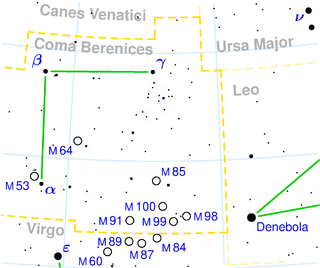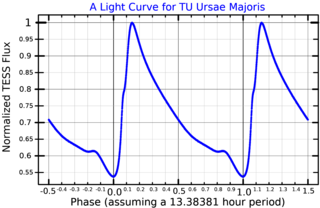Related Research Articles

SDSS J090744.99+024506.8 is a short-period variable star in the constellation Hydra. It has a Galactic rest-frame radial velocity of 709 km/s.
HD 114783 is a star with two exoplanetary companions in the equatorial constellation of Virgo. With an apparent visual magnitude of 7.56 it is too faint to be visible with the unaided eye, but is an easy target for binoculars. Based on parallax measurements, it is located at a distance of 68.7 light years from the Sun, but is drifting closer with a radial velocity of −12 km/s.

Beta Comae Berenices is a main sequence dwarf star in the northern constellation of Coma Berenices. It is located at a distance of about 29.95 light-years from Earth. The Greek letter beta (β) usually indicates that the star has the second highest visual magnitude in the constellation. However, with an apparent visual magnitude of 4.3, this star is actually slightly brighter than α Comae Berenices. It can be seen with the naked eye, but may be too dim to be viewed from a built-up urban area.
5 Aquarii is a single star in the zodiac constellation of Aquarius, located about 830 light years away from the Sun, based on parallax. 5 Aquarii is the Flamsteed designation. It is visible to the naked eye as a faint, blue-white hued star with an apparent visual magnitude of 5.55. This object is moving closer to the Earth with a heliocentric radial velocity of −3 km/s.
11 Aquilae is a single star in the equatorial constellation of Aquila. 11 Aquilae is the Flamsteed designation. It has an apparent visual magnitude of 5.2, which means it is faintly visible to the naked eye. Based upon an annual parallax shift of 20.9 mas, the distance to this star is approximately 156 light-years. The brightness of this star is diminished by 0.33 in magnitude because of extinction from interstellar gas and dust.

36 Aurigae is a single variable star located about 910 light years away from the Sun in the constellation Auriga. It has the variable star designation V444 Aurigae, while 36 Aurigae is the Flamsteed designation. This object is visible to the naked eye as a dim, white-hued star with a baseline apparent visual magnitude of 5.71. It is moving further from the Earth with a heliocentric radial velocity of +16 km/s.
Gliese 412 is a pair of stars that share a common proper motion through space and are thought to form a binary star system. The pair have an angular separation of 31.4″ at a position angle of 126.1°. They are located 15.8 light-years distant from the Sun in the constellation Ursa Major. Both components are relatively dim red dwarf stars.

1 Vulpeculae is a class B4IV star in the constellation Vulpecula. Its apparent magnitude is 4.77 and it is approximately 780 light years away based on parallax.
28 Vulpeculae is a single star in the northern constellation of Vulpecula. It lies approximately 560 light years away and is visible to the naked eye as a faint, blue-white hued star with an apparent visual magnitude of 5.047. The star is moving closer to the Sun with a heliocentric radial velocity of −23 km/s, and may come as close as 198 light-years in 5.9 million years.
In astronomy, stellar kinematics is the observational study or measurement of the kinematics or motions of stars through space.
35 Vulpeculae is a single, white-hued star in the northern constellation of Vulpecula. It is faintly visible to the naked eye with an apparent visual magnitude of 5.39. An annual parallax shift of 16.9162±0.0681 mas provides a distance estimate of about 193 light years. It is moving closer with a heliocentric radial velocity of −8 km/s.
2 Vulpeculae is a binary star system in the northern constellation of Vulpecula, located around 1,800 light years away from the Sun. It is visible to the naked eye as a faint, blue-white hued star with an apparent visual magnitude of 5.43.

KPD 1930+2752 is a binary star system including a subdwarf B star and a probable white dwarf with relatively high mass. Due to the nature of this astronomical system, it seems like a likely candidate for a potential type Ia supernova, a type of supernova which occurs when a white dwarf star takes on enough matter to approach the Chandrasekhar limit, the point at which electron degeneracy pressure would not be enough to support its mass. However, carbon fusion would occur before this limit was reached, releasing enough energy to overcome the force of gravity holding the star together and resulting in a supernova.

RT Carinae, also known as CD-58 3538, is a variable star in the Carina Nebula in the constellation Carina. It has a mean apparent magnitude of +8.55.
22 Cygni is a binary star system in the northern constellation of Cygnus. It is visible to the naked eye as a faint, blue-white hued star with an apparent visual magnitude of 4.95. The annual shift of 3.0 mas yields a distance estimate of around 1,070 light years. It is moving closer to the Earth with a heliocentric radial velocity of −15 km/s.
19 Vulpeculae is star located approximately 1,690 light years from Earth in the northern constellation of Vulpecula. It is a probable member of the open cluster NGC 6882. This object is visible to the naked eye as a faint, orange-hued star with an apparent visual magnitude of 5.40. It is moving closer to the Earth with a heliocentric radial velocity of −19 km/s.
Rho Herculis is a double star in the constellation of Hercules. The apparent magnitudes of the components are 4.510 and 5.398, respectively. Parallax measurements published in Gaia Data Release 2 put the system at some 360-390 light-years away.

Theta2 Orionis is a multiple star system in the constellation Orion. It is a few arc minutes from its more famous neighbour the Trapezium Cluster, also known as θ1 Orionis.

DU Crucis is a red supergiant and slow irregular variable star in the open cluster NGC 4755, which is also known as the Kappa (κ) Crucis Cluster or Jewel Box Cluster.

TU Ursae Majoris is a variable star in the northern circumpolar constellation of Ursa Major. It is classified as a Bailey-type 'ab' RR Lyrae variable with a period of 0.557648 days that ranges in brightness from apparent visual magnitude of 9.26 down to 10.24. The distance to this star is approximately 2,090 light years based on parallax measurements. It is located near the north galactic pole at a distance that indicates this is a member of the galactic halo.
References
- 1 2 Adelman-McCarthy, Jennifer K. (2008). "The Sixth Data Release of the Sloan Digital Sky Survey". The Astrophysical Journal Supplement Series. 175 (2): 297–313. arXiv: 0707.3413 . Bibcode:2008ApJS..175..297A. doi:10.1086/524984. S2CID 7699771.
- ↑ Brown, Warren R.; Geller, Margaret J.; Kenyon, Scott J.; Kurtz, Michael J.; Bromley, Benjamin C. (2007). "Hypervelocity Stars. III. The Space Density and Ejection History of Main-Sequence Stars from the Galactic Center". The Astrophysical Journal. 671 (2): 1708. arXiv: 0709.1471 . Bibcode:2007ApJ...671.1708B. doi:10.1086/523642. S2CID 15074398.
- ↑ Harris, Hugh C.; Liebert, James; Kleinman, S. J.; Nitta, Atsuko; Anderson, Scott F.; Knapp, Gillian R.; Krzesiński, Jurek; Schmidt, Gary; Strauss, Michael A.; Vanden Berk, Dan; Eisenstein, Daniel; Hawley, Suzanne; Margon, Bruce; Munn, Jeffrey A.; Silvestri, Nicole M.; Smith, J. Allyn; Szkody, Paula; Collinge, Matthew J.; Dahn, Conard C.; Fan, Xiaohui; Hall, Patrick B.; Schneider, Donald P.; Brinkmann, J.; Burles, Scott; Gunn, James E.; Hennessy, Gregory S.; Hindsley, Robert; Ivezić, Zeljko; Kent, Stephen; et al. (2003). "An Initial Survey of White Dwarfs in the Sloan Digital Sky Survey". The Astronomical Journal. 126 (2): 1023. arXiv: astro-ph/0305347 . Bibcode:2003AJ....126.1023H. doi:10.1086/376842. S2CID 118927660.
- ↑ Adelman-Mccarthy, J. K.; et al. (2011). "VizieR Online Data Catalog: The SDSS Photometric Catalog, Release 8 (Adelman-McCarthy+, 2011)". VizieR On-line Data Catalog. Bibcode:2011yCat.2306....0A.
- 1 2 Brown, A. G. A.; et al. (Gaia collaboration) (August 2018). "Gaia Data Release 2: Summary of the contents and survey properties". Astronomy & Astrophysics . 616. A1. arXiv: 1804.09365 . Bibcode: 2018A&A...616A...1G . doi: 10.1051/0004-6361/201833051 . Gaia DR2 record for this source at VizieR.
- ↑ Brown, Warren R. (2006). "Hypervelocity Stars. I. The Spectroscopic Survey". The Astrophysical Journal. 647 (1): 303–311. arXiv: astro-ph/0604111 . Bibcode:2006ApJ...647..303B. doi:10.1086/505165. S2CID 15561164.
- 1 2 3 4 Przybilla, N.; Nieva, M. F.; Tillich, A.; Heber, U.; Butler, K.; Brown, W. R. (2008). "HVS 7: A chemically peculiar hyper-velocity star". Astronomy & Astrophysics. 488 (2): L51–L54. arXiv: 0810.0864 . Bibcode:2008A&A...488L..51P. doi:10.1051/0004-6361:200810455. S2CID 56111543.
Such a surface abundance pattern is caused by atomic diffusion in a possibly magnetically stabilised, non-convective atmosphere. Hence all chemical information on the star’s place of birth and its evolution has been washed out. High precision astrometry is the only means to validate a GC origin for HVS 7.
- 1 2 Brown, Warren R.; Geller, Margaret J.; Kenyon, Scott J.; Kurtz, Michael J. (2006). "Hypervelocity Stars. I. The Spectroscopic Survey". The Astrophysical Journal. 647 (1): 303–311. arXiv: astro-ph/0604111 . Bibcode:2006ApJ...647..303B. doi:10.1086/505165. S2CID 15561164.
Here we report the two most recently discovered HVSs: SDSS J110557.45+093439.5 and possibly SDSS J113312.12+010824, traveling with Galactic rest-frame velocities at least +508+/-12 and +418+/-10 km s-1, respectively.